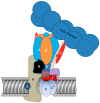Specialized Roles for Actin in Osteoclasts: Unanswered Questions and Therapeutic Opportunities
- PMID: 30634501
- PMCID: PMC6359508
- DOI: 10.3390/biom9010017
Specialized Roles for Actin in Osteoclasts: Unanswered Questions and Therapeutic Opportunities
Abstract
Osteoclasts are cells of the hematopoietic lineage that are specialized to resorb bone. In osteoclasts, the actin cytoskeleton engages in at least two unusual activities that are required for resorption. First, microfilaments form a dynamic and structurally elaborate actin ring. Second, microfilaments bind vacuolar H⁺-ATPase (V-ATPase) and are involved in forming the V-ATPase-rich ruffled plasma membrane. The current review examines these two specialized functions with emphasis on the identification of new therapeutic opportunities. The actin ring is composed of substructures called podosomes that are interwoven to form a cohesive superstructure. Studies examining the regulation of the formation of actin rings and its constituent proteins are reviewed. Areas where there are gaps in the knowledge are highlighted. Microfilaments directly interact with the V-ATPase through an actin binding site in the B2-subunit of V-ATPase. This binding interaction is required for ruffled membrane formation. Recent studies show that an inhibitor of the interaction blocks bone resorption in pre-clinical animal models, including a model of post-menopausal osteoporosis. Because the unusual actin-based resorption complex is unique to osteoclasts and essential for bone resorption, it is likely that deeper understanding of its underlying mechanisms will lead to new approaches to treat bone disease.
Keywords: V-ATPase; actin; actin polymerization; anti-resorptives; bone; bone remodeling; microfilament; vacuolar H+-ATPase.
Conflict of interest statement
The authors declare that they have no conflict of interest.
Figures





Similar articles
-
Interaction between vacuolar H(+)-ATPase and microfilaments during osteoclast activation.J Biol Chem. 1999 Oct 8;274(41):29164-71. doi: 10.1074/jbc.274.41.29164. J Biol Chem. 1999. PMID: 10506172
-
Actin binding activity of subunit B of vacuolar H+-ATPase is involved in its targeting to ruffled membranes of osteoclasts.J Bone Miner Res. 2006 May;21(5):714-21. doi: 10.1359/jbmr.060201. J Bone Miner Res. 2006. PMID: 16734386
-
Interactions between vacuolar H+-ATPases and microfilaments in osteoclasts.J Bioenerg Biomembr. 2005 Dec;37(6):419-23. doi: 10.1007/s10863-005-9483-y. J Bioenerg Biomembr. 2005. PMID: 16691476 Review.
-
Vacuolar H+-ATPase binding to microfilaments: regulation in response to phosphatidylinositol 3-kinase activity and detailed characterization of the actin-binding site in subunit B.J Biol Chem. 2004 Feb 27;279(9):7988-98. doi: 10.1074/jbc.M305351200. Epub 2003 Dec 8. J Biol Chem. 2004. PMID: 14662773
-
Rational identification of enoxacin as a novel V-ATPase-directed osteoclast inhibitor.Curr Protein Pept Sci. 2012 Mar;13(2):180-91. doi: 10.2174/138920312800493151. Curr Protein Pept Sci. 2012. PMID: 22044158 Free PMC article. Review.
Cited by
-
Ectodysplasin A1 Deficiency Leads to Osteopetrosis-like Changes in Bones of the Skull Associated with Diminished Osteoclastic Activity.Int J Mol Sci. 2022 Oct 13;23(20):12189. doi: 10.3390/ijms232012189. Int J Mol Sci. 2022. PMID: 36293046 Free PMC article.
-
l-tetrahydropalmatine suppresses osteoclastogenesis in vivo and in vitro via blocking RANK-TRAF6 interactions and inhibiting NF-κB and MAPK pathways.J Cell Mol Med. 2020 Jan;24(1):785-798. doi: 10.1111/jcmm.14790. Epub 2019 Nov 14. J Cell Mol Med. 2020. PMID: 31725199 Free PMC article.
-
Structure and function of the membrane microdomains in osteoclasts.Bone Res. 2023 Nov 21;11(1):61. doi: 10.1038/s41413-023-00294-5. Bone Res. 2023. PMID: 37989999 Free PMC article. Review.
-
Anti-rheumatic property and physiological safety of KMU-11342 in in vitro and in vivo models.Inflamm Res. 2024 Aug;73(8):1371-1391. doi: 10.1007/s00011-024-01904-6. Epub 2024 Jun 15. Inflamm Res. 2024. PMID: 38879731 Free PMC article.
-
Update on the pathogenesis and genetics of Paget's disease of bone.Front Cell Dev Biol. 2022 Aug 12;10:932065. doi: 10.3389/fcell.2022.932065. eCollection 2022. Front Cell Dev Biol. 2022. PMID: 36035996 Free PMC article. Review.
References
-
- Vaananen H.K., Karhukorpi E.K., Sundquist K., Wallmark B., Roininen I., Hentunen T., Tuukkanen J., Lakkakorpi P. Evidence for the presence of a proton pump of the vacuolar H(+)-ATPase type in the ruffled borders of osteoclasts. J. Cell Biol. 1990;111:1305–1311. doi: 10.1083/jcb.111.3.1305. - DOI - PMC - PubMed
-
- Bromme D., Okamoto K., Wang B.B., Biroc S. Human cathepsin O2, a matrix protein-degrading cysteine protease expressed in osteoclasts. Functional expression of human cathepsin O2 in Spodoptera frugiperda and characterization of the enzyme. J. Biol. Chem. 1996;271:2126–2132. doi: 10.1074/jbc.271.4.2126. - DOI - PubMed
Publication types
MeSH terms
Substances
Grants and funding
LinkOut - more resources
Full Text Sources

